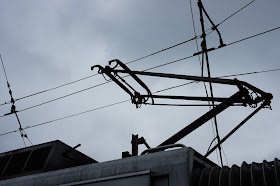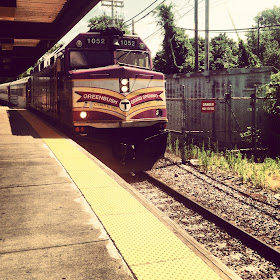Here is Boston to a T's list of MBTA "Delay Terms" and our interpreted definitions.
Mechanical failures
A mechanical failure can include any failures related to locomotion, braking (traction, pneumatic) and electricity. Due to the fact that commuter rail operation is such a dynamic system involving multiple systems working together, many issues can constitute a mechanical failure. Engine failure can relate to either the main driver engine which powers the locomotive or to the Head End Power (H.E.P.) generator which generates all of the electricity & power for the train set. Mechanical failures happen all to often, this is due to the age of the MBTA's locomotive fleet (the majority of which are over 30 years old).
Disabled Train
A train can become "disabled" due to a number of different problems. The trains AC or DC traction motors and propulsion system may blow out and prevent the train from moving, the braking system may not be working properly, there may be an electrical problem, or a computer fault. Any number of "mechanical failures" will cause a train to be "disabled".
Signal Problem
One of the most common reasons for a signal problem is the interruption of a circuit between a signal and the signal's relay. This would cause all signals within an area (or block) to go to red. This will result in any train within the block to have to stop (and of course all trains behind it) until the prblem can be resolved. Sometimes it will reset on its own, other times signal personnel have to go to the signal, and check all the signals in the area to see where the prioblem started and then correct it. This takes time, and thus causes delays. Signal problems can occur all over the MBTA system. There are a few lines, however, that these delays are much more common. Due to the age of it's signal system the Fithcburg line is constantly plagued by delays. There are however plans in place to fully upgrade that system.
Speed Restriction
 |
| A heat kink on the WMATA Photo: WMATA |
Medical Emergency
Although medical emergencies are somewhat self explanatory, there are still a few different things that can cause one to be put into place. Someone can be physically sick or hurt on a train and need the assistance of an ambulance. This causes the train to move to the nearest station and standby until medical personnel and transit police can arrive. The train will not be released until the scene is cleared. Another cause can be a trespasser being struck by a train. Accidents like this will cause major delays on that rail line. There will be extensive police activity, and speed restrictions will be put into place if other trains are able to pass the scene.
 |
| A fire at Chinatown Station in 2012 |
Police / Fire Department Activity
Police and Fire department activity is a delay that happens anytime the police or fire departments need to be called to an MBTA train, station, or other property. It could be because of an unruly passenger, an electrical fire in a station, or a person jumping into the subway pit.
Amtrak Interference (Providence/Stoughton/Lowell/Haverhill)
This delay is just as it states. Trains are delayed due to an interference with an Amtrak train. Usually these delays happen on the Northeast Corridor (which Amtrak owns and therefore has priority over MBTA trains). If an Amtrak train is late it will then cause the trains that follow it to be late. This can also happen on the Lowell and Haverhill lines where Amtrak's Downeaster runs.
Freight Interference (Fitchburg/Worcester)
Once again this is just as it states. Trains are delayed due to an interference with a freight train. Usually these delays happen on the Fitchburg and Framingham/Worcester Lines. CSX and PanAm Railways are the prime culprits, in this area, when it comes to freight interference.
Downed Wire
 |
| MBTA Type-8 LRV pantograph and catenary. |
A downed wire can cause MAJOR delays on the railroad. Currently only the Green Line, part of the Blue Line and the entire Northeast Corridor have over head electric wire. Over head electric wire, or catenary, is a system of overhead wires used to supply electricity to a locomotive, streetcar, or light rail vehicle which is equipped with a pantograph. Non-electric trains (such as the MBTA's diesel locomotives) may pass along these tracks without affecting the catenary. Downed catenary wires can be caused by tree limbs falling over, high winds, and broken support brackets.


